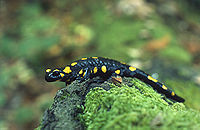|
Vikidia currently has 4,623 articles. Improve it! |
|
Join Vikidia: create your account now and improve it! |
Amphibian
Amphibians (scientific name : Amphibia) are a large group of animals, which use to live in moist places (most often). Frogs belong to this group, but not only.
Most amphibians have four limb, and a bony skeleton, including a vertebral column : they thus belong to the Vertebrate group, and even to the Tetrapodes, meaning they are relatives to reptiles, birds and mammals.
Their name means "who lives in both", because they live both in water and in air : the young amphibians are larvae, called tadpoles, with gills, who live and breath in water. When they grow up, they turn into adult (it is said : a metamorphosis) : they loose their gills (most often), and gain lungs instead. They become able to breath in the air, but most of amphibians won't venture far away from the water, anyway. Their skin is nude, with no scales, nor fur or even feathers : they have to keep it wet, in order to survive. Amphibians also need water to spawn their eggs.
There are three kinds of different amphibians around the world, making three different groups :
Frogs[edit | edit source]
Frogs constitute the group of Anuran ; they are characterized by having no tail (Anura is a Greek word meaning "no tail"), and [[69]-shape folded legs, which allow them to jump.
Frogs with warts are called toad.
Salamanders[edit | edit source]
Salamanders constitute the group of Urodela. They are lizard-like animals, with an elongated body and a long tail ; anyway, they're not close relatives to the lizards, nor the reptiles : with a nude skin, eggs laid in water, giving birth to tadpoles, they are true cousins of the frogs.
Salamanders with spend their whole life (or most of it) in the water are called newt.
Some kinds of salamanders keep their gills during their whole life, even when they turn to adult, such as the olm or the axolotl, who live in caves.
Caecilians[edit | edit source]
Caecilians constitute the strange group of the Apoda (Greek word meaning "no leg"). These snake-like, or worm-like amphibians, indeed, have no legs, and crawl on the ground. Despite this, they are not close relatives of the reptiles, and even less to the worms : they would be better described as some kind of legless salamanders...
Very few is known about them ; they live in tropical area.

|
Animals Portal — All articles about animals |


